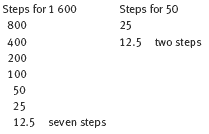This is a level 3 number activity from the Figure It Out series. It relates to Stage 6 of the Number Framework.
A PDF of the student activity is included.
Click on the image to enlarge it. Click again to close. Download PDF (613 KB)
use doubling and halving strategies
The strategy of doubling and halving can be used to show the connection between division and multiplication by a basic fraction, such as a half or a quarter.
Activity One
In this activity, the strategy of halving also shows the connection between the common fraction of one-half and its decimal equivalent of 0.5 because this will be the result of halving any whole number until a number with a decimal point is reached.
The interest in this activity is in the number of steps it takes to get to the number with a decimal point. Some students may assume that larger numbers will require more steps, so be sure to compare the number of steps it takes when we start from 2 000 (five steps) with the number of steps it takes from 2 500 (three steps).
Encourage the students to explore the number of steps it takes to reach a number with a decimal point for numbers that end in the same quantity, for example, 7 500, 6 500, 3 500, and 500. This way, they will see that the number of steps depends on the first significant figure (that is, the first non-zero figure, in this case, the 5). All the other significant figures have no influence.
The students could then investigate putting any odd number in the ones place, then in the tens place, and then in the hundreds place. They will find that it is the place the odd number is in that decides how many steps it takes to reach a decimal fraction.
An investigation into even numbers is quite a different matter because for any even number, you first have to halve the number until you produce a number where the first significant figure is odd and then you proceed with the steps to a decimal fraction.
By comparing the number of steps for 1 600 and 50, we can see the effect:
Activity Two
Here the process is reversed so that the students can see the effect of doubling. Note that, in the first question, Jarod will not reach exactly 1 000 000 by doubling from 1 000, but it will take him 10 steps to go past that number.
A good context that many students will relate to is the way the size of the memory on computers usually grows in doubles. A chart such as the one below may be helpful. As an extension, the megabyte increases could be shown as powers of 2.
1 megabyte = 21
2 megabytes = 22
4 megabytes = 23
8 megabytes = 24
16 megabytes = 25
32 megabytes = 26
64 megabytes = 27
128 megabytes = 28
256 megabytes = 29
512 megabytes = 210
Answers to Activities
Activity One
1. a. 2 000
1 000
500
250
125
62.5
b. 2 500
1 250
625
312.5
c. 32
16
8
4
2
1
0.5
2. Numbers will vary. They are all odd numbers.
3. Numbers will vary. They all end up as an odd number after the second halving.
Activity Two
1. 10 times. (On the tenth doubling, he got 1 024 000.)
2. 9 days (counting the $40.00 as 1 day)

